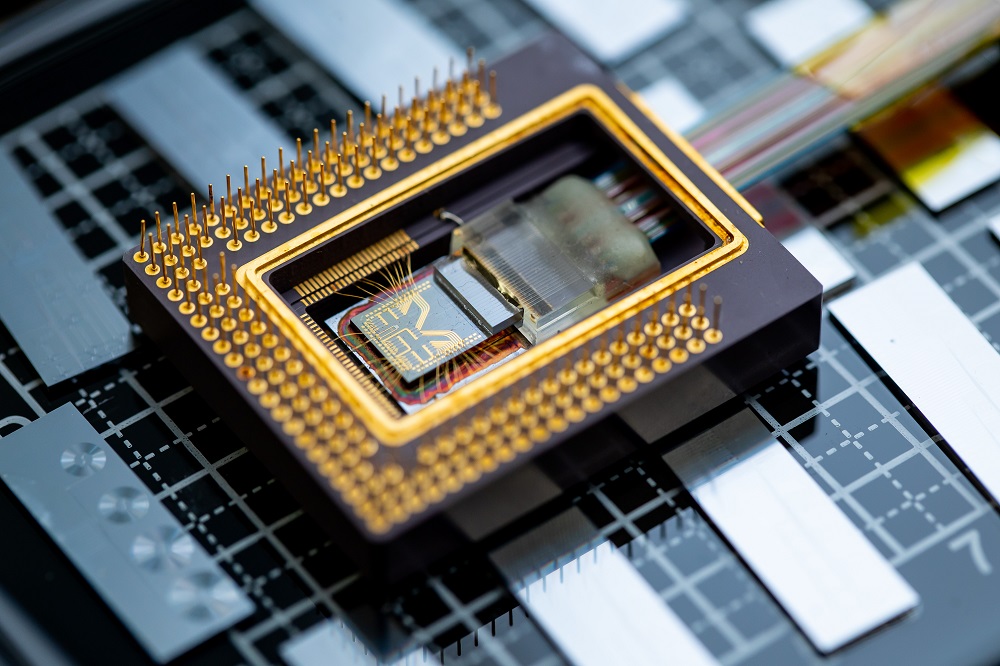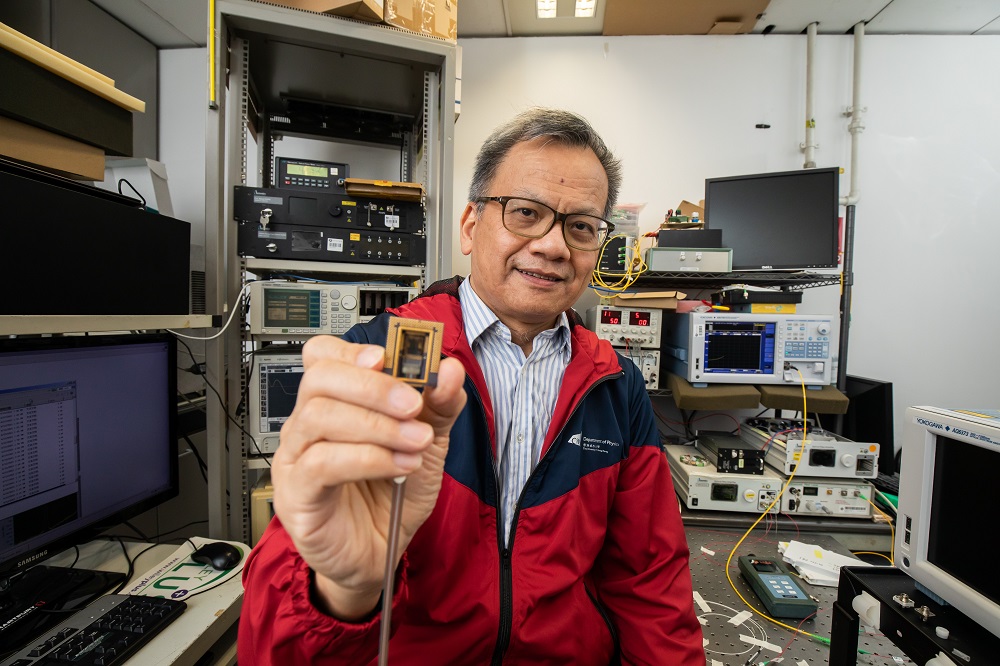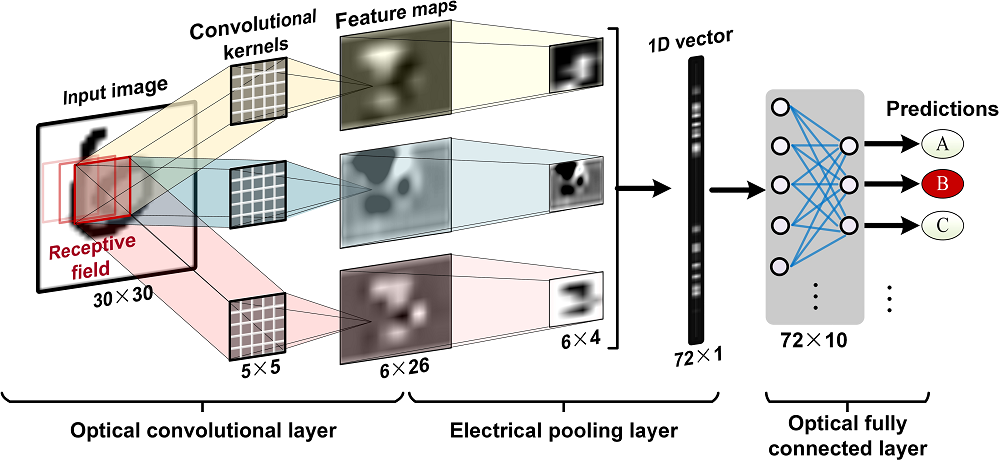Novel chip by CityU physicist helps to build the world’s fastest optical neuromorphic processor
In the era of Artificial Intelligence (AI), a novel optical “micro-comb” chip developed by a physicist from the City University of Hong Kong (CityU) has played a pivotal role in building the fastest optical neural network processor. An international research team has recently demonstrated the world’s fastest and most powerful optical neural network processor, which is capable of operating at faster than 10 trillion operations per second. When applied to handwritten digital recognition, a common benchmark in AI, it achieved an accuracy of nearly 90%. It represents an enormous leap forward for neural networks and neuromorphic processing.
Led by Professor David J. Moss of the Swinburne University of Technology (Swinburne), this collaborative study’s findings have been published in the prestigious journal Nature, titled "11 TOPS photonic convolutional accelerator for optical neural networks". Dr Chu Sai-tak, Associate Professor in the Department of Physics at CityU and Dr Brent E. Little from Xi’an Institute of Optics co-developed the integrated optical micro-comb chip in the photonic processors used in the study. And this magical micro-comb chip is the secret to the record-breaking speed.
Micro-comb chip: Key to the record-breaking speed
In the study, the international team of researchers has demonstrated the world’s fastest optical neural processor for AI can operate at faster than 10 trillion operations per second, or more than 1,000 times faster than any previous single optical processor of its kind. It can process ultra-large-scale images of 250,000 pixels, which is something that other optical processors have been unable to accomplish, making more complicated AI applications like facial recognition possible. The breakthrough was achieved with optical micro-combs.
Although cutting-edge electronic processors such as those from Google can operate at even higher speed, it requires tens of thousands of parallel processors. But this study only used a single optical processor.
Achieved almost 90% accuracy when applied to handwritten digital recognition
The system developed by the team operated at unprecedented high speed with the new technique of simultaneously interleaving the data in time, wavelength and spatial dimensions through an integrated micro-comb source. The new processor allowed rapid comparison of ultra-large-scale images and made successful recognition of handwritten digit images at 88 per cent accuracy in the experiment.
“This is another demonstration of the versatile integrated optical micro-comb chip that we have developed. Along with the earlier contribution on breaking the internet speed record in telecommunication to the on-chip generation of high-dimensional entangled quantum states in quantum processing, the micro-comb chip continues to find new and exciting applications in the field of science and technology.” Dr Chu said.

Inside the novel chip developed by Dr Chu and Dr Little, there is a micro-ring resonator which can generate an optical frequency response call “micro-comb” (creates uniform frequency lines that are equidistant and looks like a comb). It acts like a rainbow, and a single micro-comb can replace dozens of parallel laser sources with different wavelengths. Micro-comb is essential in advanced optical processing as it is faster and smaller than any other optical sources, and it doesn’t have the problem of the electronic bottleneck.

“Optical processing has the advantages of overcoming the electronic bottleneck, which will eventually limit the capability and speed of the current electronic processors. This is especially important to applications that require a huge amount of complex mathematical operations such as in AI image processing using many layers of interconnected artificial neurons. The micro-comb chip that we developed has extremely low loss and very high-quality factors. It has highly uniform and coherent frequency lines at the output. The study finds that micro-comb can be a very efficient optical neural network processor.” Dr Chu added.
Convolutional neural networks (CNN), inspired by the biological structure of the brain’s visual cortex system, are a powerful category of artificial networks that can extract key hierarchical features of raw data to predict properties and behaviour. CNN can greatly reduce the complexity of raw data and enhance the accuracy of prediction. An artificial neural network is a key form of AI that can learn and perform complex operations with wide applications in facial recognition, computer vision, medical diagnosis, speech recognition, natural language processing, autonomous vehicles and playing strategy games.

The international research collaboration was led by Professor Moss; Dr Mike Xu Xingyuan (from Swinburne and Monash University (Monash) and Distinguished Professor Arnan Mitchell from RMIT University (RMIT) with key support from Tan Mengxi and Dr Wu Jiayang from Swinburne; Professor Damien Hicks from Swinburne and Walter and Elizabeth Hall Institute of Medical Research (WEHI); Andreas Boes and Thach G Nguyen from RMIT; Dr Bill Corcoran from Monash; Dr Chu from CityU; Dr Little from Xi’an Institute of Optics; and Roberto Morandotti from INRS Énergie Matériaux Télécommunications Research Centre.
DOI number: 10.1038/s41586-020-03063-0
Related story: New chips developed by CityU physicist help break spectral efficiency record for optical data transmission
